Filters: Tags: blm (X)
10,055 results (21ms)|
Filters
Date Range
Extensions (Less)
Types (Less)
Contacts (Less)
Categories (Less) Tag Types
|
This file contains the polygon SDE Feature Class for Federal Fluid Minerals(Oil and Gas) for the Bureau of Land Management(BLM)Montana/Dakotas. Federal Fluid Minerals as well as Federal Lease status and Indian Minerals/Leases are included. Plat maps are used to find federal mineral ownership and the Bureau of Land Management's LR2000 database is used to find current leasing status.
Categories: Data;
Types: Citation,
Downloadable,
Map Service,
OGC WFS Layer,
OGC WMS Layer,
OGC WMS Service,
Shapefile;
Tags: BLM,
Bureau of Land Management,
boundaries,
energy leasing,
environment,
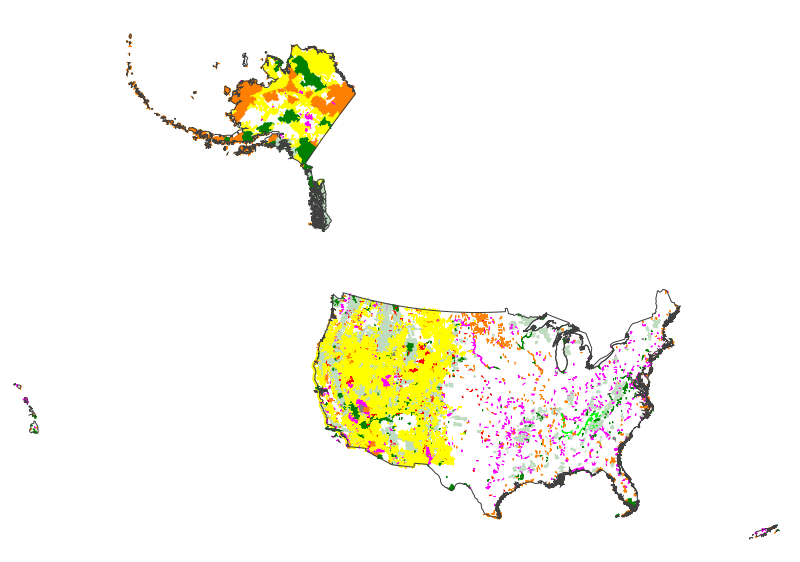
This map layer consists of federally owned or administered lands of the United States, Puerto Rico, and the U.S. Virgin Islands. For the most part, only areas of 320 acres or more are included; some smaller areas deemed to be important or significant are also included. There may be private inholdings within the boundaries of Federal lands in this map layer. Some established Federal lands which are larger than 320 acres are not included in this map layer, because their boundaries were not available from the owning or administering agency.
Background information.—On July 8, 2012, lightning ignited a fire on Bureau of Land Management-managed land on the Miller Homestead in Harney County, Oregon. High winds combined with unusually hot and dry conditions spread the fire through dry grass and sagebrush and 160,801 acres were burned before the fire was contained on July 24, 2012. In the aftermath, it was determined that ecological restoration was necessary since the majority of the fire occurred within prime habitat for sage-grouse, and the fire had burned with such severity that it removed vegetation down to bare soil. Without rehabilitation efforts, desirable vegetation would be unlikely to reestablish and the site would be open to invasion by noxious...
Categories: Project;
Types: Map Service,
OGC WFS Layer,
OGC WMS Layer,
OGC WMS Service;
Tags: BLM,
Bank stabilization/erosion control,
Bureau of Land Management (BLM),
Fire,
Habitat-based,
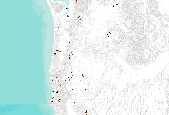
The Institute for Bird Populations (IBP) coordinates the Monitoring Avian Productivity and Survivorship (MAPS) Program to assess and monitor the vital rates and population dynamics of North American landbirds. The MAPS Program utilizes a standardized constant-effort mist netting and banding protocol (DeSante et al. 2010) at a continent-wide network of monitoring stations. Each summer dedicated volunteers operate bird-banding stations to collect data on individual "birds-in-the-hand" representing over 200 species. Analyses of MAPS data provide critical information relating to the ecology, conservation, and management of North American landbird populations and the factors responsible for changes in their populations....
The mine permit boundary coverage was created for locational purposes and to aid counties in tax district assessment.
Rights of Way Corridors
Categories: Data;
Types: Downloadable;
Tags: BLM,
Corridors,
Federal Government,
Lands and Realty,
ROW,
The northern leopard frog (Rana pipiens) is a formerly abundant frog that has experienced significant declines across its range and is considered endangered in some parts of the range but still abundant in other parts of the range. Various factors have been invoked to explain population declines in the northern leopard frog, including habitat destruction, diseases, chemical contamination, acidification, increased ultraviolet light due to loss of the ozone layer, introduced predators, overcollecting, climatic changes, and general environmental degradation. However, no one cause has emerged as the primary factor behind population declines in any area. Probably, multiple causes contribute to population...
This theme is polygon data that depicts two types of development for the state of Wyoming. The first is existing development and the second are habitats where there is a high likelihood that development will occur in the near future. We considered development of oil, gas and coal bed methane, mining of minerals (trona, uranimum, coal, and bentonite), urban expansion. Other infrastructure activities such as roads, highways, fiberoptic lines, processing plants, pipelines, other facilities, and various combinations of development that were believed to impact sage-grouse were recorded. Information sources and assessment processes varied depending on data available and resource specialist participation for areas within...
Categories: Data;
Types: Downloadable;
Tags: BLM,
Federal Government,
Wyoming,
biota,
developed habitat,
This page contains links to images of the Public Land Survey System for Wyoming. This information consists of images of all available survey plats for the entire state and approximately 30,000 pages of field notes. The plats are organized by county and then by township and range. The remaining 570,00 pages of field notes are in bound volumes and will not be available for quite some time. Additionally we have now posted all the available images for the Mineral and HES surveys.
Categories: Data;
Types: Static Map Image;
Tags: BLM,
Federal Government,
boundaries,
planningCadastre

These data describe areas of suitable habitat believed to be used (currently and historically) by wild, natural, and/or hatchery fish populations. The term "currently" is defined as within the past five reproductive cycles. See the 'USETYPE' field description to differentiate between current and historic distribution. This information is based on extensive surveys, the best professional judgment of ODFW staff biologists and where possible, the professional opinions of staff from other natural resource agencies. Due to natural variations in run size, water conditions, or other environmental factors, some areas displayed may not be used by a species of fish on an annual basis. The Natural Resources Information Management...
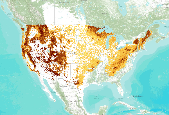
Hermit Warbler - VizBand/Land AIC Model Selection Created: 12-Aug-2011 Hermit Warbler annual capture rate of adult (ADULT) individuals (log transformed) ranged between -0.281 and +2.243 with a mean value of +0.981 and a median value of +0.875. ________________________________________ Model 1 (3 parameters) Hermit Warbler annual capture rate of adult (ADULT) individuals (log transformed) was a function of: a) GTOPO30_AL (+0.20641) - elevation (m), ranged between +5.119 and +8.376 (95% CL) with a mean value of +6.747 and a median value of +7.137, b) NLCD06AG5KP (-0.19572) - percent agricultural/grassland cover, 990m-resolution in a landscape context of 5km radius, ranged between -0.657 and +2.530 (95% CL) with a mean...

This theme shows broadleaf cover for the Coast Oregon physiographic province of the Interagency Vegetation Mapping Project (IVMP). The Interagency Vegetation Mapping Project (IVMP) provides maps of existing vegetation, canopy cover, size, and cover type for the entire range of the Northern Spotted Owl using satellite imagery from the Landsat Thematic Mapper (TM). This area is commonly called the FEMAT area, in reference to the area's analysis by the Forest Ecosystem Management Assessment Team. A regression modeling approach was used to predict vegetation characteristics from this Landsat data. This process involved the use of numerous sources of ancillary data, the most crucial being USFS, BLM, and Forest Inventory...
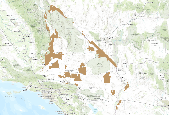
This is an aggregate dataset for the DRECP 12 km buffer region, depicting the geographic boundaries of Grazing Allotments within BLM managed public lands. An allotment is an area of land designated and managed for grazing of livestock (43 CFR 4100.0-5). An allotment may include private, state, and public lands under the jurisdiction of the Bureau of Land Management and/or other federal agencies. An allotment may be subdivided into pastures. Range improvement projects are not depicted within this dataset.
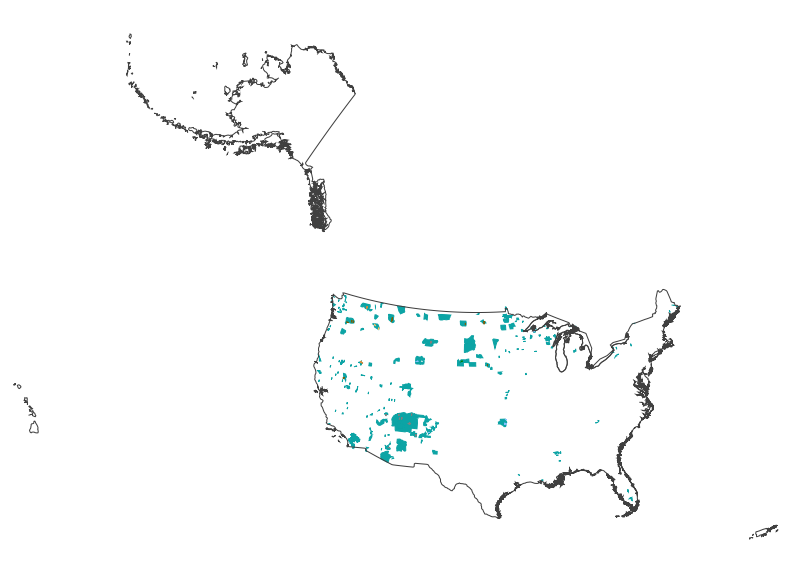
This map layer shows Indian lands of the United States. For the most part, only areas of 320 acres or more are included; some smaller areas deemed to be important or significant are also included. Federally-administered lands within a reservation are included for continuity; these may or may not be considered part of the reservation and are simply described with their feature type and the administrating Federal agency. Some established Indian lands which are larger than 320 acres are not included in this map layer because their boundaries were not available from the owning or administering agency.
This dataset is a raster of current predicted suitable bioclimate using statistical correlations between known habitat and current climate (1950-1999 average). 0=Absence; 1=Presence*see Maxent output pdf for details on model parameters.
This dataset is a raster summarizing the change in suitable bioclimate by looking at the difference between current and A2 2050s. Value coding:-3 = Lost bioclimate; 0 = absence (current and future); 1= maintained bioclimate; 4 = gained bioclimate
This data set contains distribution information for all terrestrial and aquatic reptiles, crocodilians, and turtles occurring in the United States and Canada.
This dataset is a raster of current predicted suitable bioclimate using statistical correlations between known habitat and current climate (1950-1999 average). 0=Absence; 1=Presence*see Maxent output pdf for details on model parameters.
This dataset is a raster of current predicted suitable bioclimate using statistical correlations between known habitat and current climate (1950-1999 average). 0=Absence; 1=Presence*see Maxent output pdf for details on model parameters.
This dataset is a raster summarizing the change in suitable bioclimate by looking at the difference between current and A2 2050s. Value coding:-3 = Lost bioclimate; 0 = absence (current and future); 1= maintained bioclimate; 4 = gained bioclimate
|

|